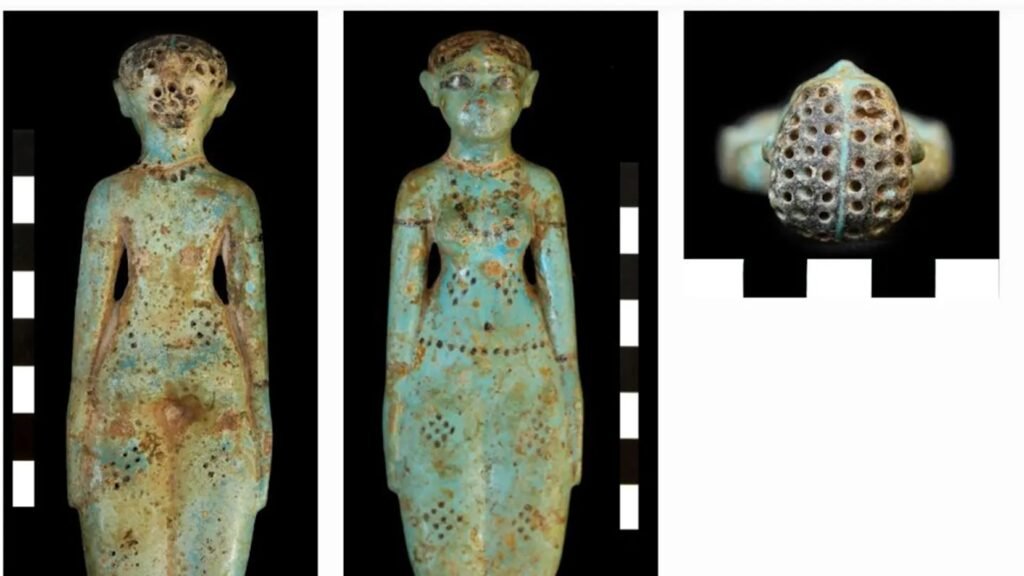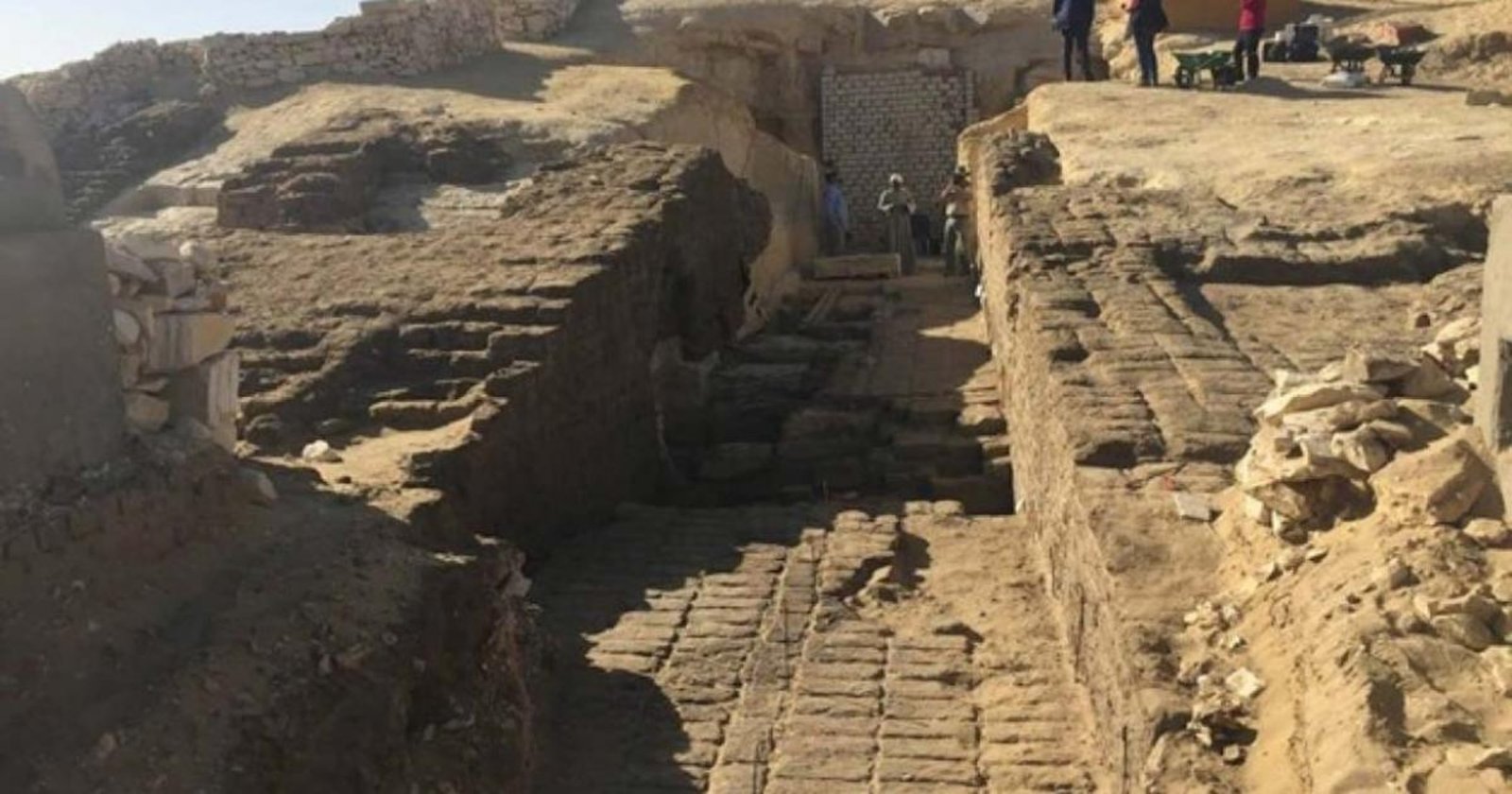In the vast, sun-drenched expanse of Upper Egypt, history has once again whispered its secrets from beneath the sands. The South Asasif necropolis, nestled on the West Bank of Luxor, has offered up a New Archaeological Discovery in Egypt that reshapes our understanding of this ancient landscape. The joint Egyptian-American archaeological mission has successfully uncovered the first Middle Kingdom-era tomb at the South Asasif necropolis—an exciting and rare insight into the era’s funeral customs and craftsmanship.
The mission’s efforts have led to the new tomb discovery in Egypt of an intact burial site dating to the Middle Kingdom, a period roughly spanning 1938-1630 BC. This burial site, belonging to a family that lived during the 12th and early 13th Dynasties, holds eleven individual burials. Each skeletal remain tells a story—a story of generations past, and of an intricate network of kinship that survived the test of time. Ancient tomb unearthed in Egypt is perhaps a more fitting way to describe the scene, as the tomb had lain hidden for nearly 4,000 years beneath the sand and ruins of Asasif, waiting for its secrets to be brought to light.
A Remarkable Discovery in Asasif
The tomb, located adjacent to the grand Temple of Hatshepsut, brings into focus a previously unknown facet of the necropolis. Until this discovery, the South Asasif necropolis was primarily associated with burials from the Late Period and the Kushite Dynasty. The newfound Middle Kingdom tomb rewrites the history of the necropolis and opens up new avenues for research, as this is the first Egyptian Middle Kingdom era tomb uncovered in Asasif necropolis.
Mohamed Ismail Khaled, secretary-general of the Supreme Council of Antiquities (SCA), highlighted the historical significance of this tomb, suggesting it could mark the start of uncovering other unknown Middle Kingdom burials within the area. This shift changes the established narrative of the Asasif region, elevating it to one of the significant Middle Kingdom cemeteries, in addition to its already established importance in the Late Period of ancient Egypt.
The family tomb spans several chambers, with many burials showing clear signs of reuse over generations. The skeletal remains of men, women, and children found within the tomb attest to its role as a family burial complex. Despite the extensive damage caused by ancient floods that destroyed much of the wooden coffins and linen wrappings, the durable items—such as jewellery, pottery, and offering items—have survived in remarkable condition. These remnants offer insight into the funerary customs and artistry of the time, revealing a fascinating glimpse into the past.
Jewellery and Artifacts: A Glimpse into the Past
Within the tomb, the team uncovered a dazzling array of artifacts—items that were intended to accompany the deceased on their journey into the afterlife. Among the artefacts were new pharaoh artifacts discovered that shed light on the Middle Kingdom’s artistic and religious traditions. Jewellery items included necklaces, rings, bracelets, and chains crafted from semi-precious stones, as well as faience and stone inlays.

Hisham El-Leithy, head of the Egyptian Antiquities Preservation and Documentation Sector, described a particularly impressive piece: a unique necklace made of thirty amethyst beads, flanked by two cylindrical agate beads, and completed with a hippopotamus-head amulet. The hippo, a symbol of rebirth and protection, would have been a powerful charm for the deceased, reflecting the deep-seated belief in the protective forces of the natural world.
Copper mirrors were also found within two of the burials. One of these mirrors bore a lotus flower handle, an emblem of beauty and rebirth, while the other depicted the goddess Hathor—in a striking representation, Hathor is shown with four stern expressions, hinting at her multifaceted nature as a deity. The tomb also contained copper ingots, perhaps used as offerings or trade items, and a small fertility figurine. The figurine, with its intricately painted black hair and adorned with jewelry, speaks to the values placed on fertility and the continuity of life.
Burials Across Generations
The eleven burials within the tomb ranged from adults to children, indicating that the tomb served as a familial resting place across generations. Many of these burials bore the hallmarks of flood damage—wooden coffins were split and shattered, and linen wrappings were disheveled or destroyed. However, the burial site discovery in Egypt also yielded remarkably well-preserved pottery, as well as stone offering tables carved with motifs of bulls’ heads, bread, and other items essential for sustaining the deceased in the afterlife.
The presence of such a diverse range of artifacts, and the state of preservation of some of these items, provides crucial evidence of Middle Kingdom funerary practices. The ceramic items, often decorated with symbols of prosperity and life, were offerings meant to ensure the well-being of the deceased in the hereafter. Moreover, the copper mirrors and jewellery found within the tomb suggest that the individuals interred here were of considerable social standing, perhaps members of a local elite or administrative class.
Shifting Narratives of the Asasif Necropolis
Until this point, the Asasif necropolis had been celebrated largely for its Kushite and Late Period burials, notably those associated with the 25th Dynasty. The new tomb discovery in Egypt from the Middle Kingdom now presents an additional layer of historical richness to the site, highlighting the significance of Asasif as a continuous burial ground for centuries. This finding suggests that Asasif, and by extension, the Theban necropolis, played a far more significant role during the Middle Kingdom than previously recognized.
Dr. Catherine Blakeney, head of the American side of the mission, emphasized that the craftsmanship and preservation of the artefacts found in this tomb contribute to a greater understanding of Middle Kingdom burial customs. The elaborate jewellery and ceremonial items found provide glimpses into the daily lives, spiritual practices, and aesthetic sensibilities of the people who lived almost four millennia ago.
The intricate animal amulets, for example, reveal the Egyptians’ profound respect for the natural world and their belief in its power to provide protection and bring good fortune. The fertility figurine and the copper mirrors also suggest a society deeply concerned with the ideals of beauty, continuity, and divine favor.
Continuing the Excavation: What Lies Ahead
The excavation at Asasif is far from over. The team has only scratched the surface of what could be an extensive series of burials from the Middle Kingdom period. The Egyptian-American mission is determined to continue their efforts, with hopes of revealing more tombs that could contain additional insights into the lives of those who were laid to rest in this significant necropolis.

Mohamed Ismail Khaled conveyed his optimism about the potential of further finds at Asasif. The collaboration between the Supreme Council of Antiquities and international teams has demonstrated the power of shared knowledge and expertise in uncovering the past. As excavations continue, the focus will be on careful preservation, ensuring that these new insights into the Middle Kingdom can be shared with the world for generations to come.
The excavation of this ancient tomb unearthed in Egypt is a remarkable milestone in Egyptology, illustrating how much more there is to learn about this fascinating period. Each artefact, from amethyst necklaces to copper mirrors, tells part of the story of an ancient people—revealing not only how they lived and died, but also what they valued, revered, and believed about the world and the afterlife.
A New Chapter in Egypt’s Past
The new archaeological discovery in Egypt at the South Asasif necropolis has unearthed a treasure trove of information that will significantly shape our understanding of the Middle Kingdom’s presence in Upper Egypt. This discovery highlights the importance of the Asasif necropolis as a historical and cultural repository, offering a glimpse into a complex period of Egyptian history characterized by social continuity, craftsmanship, and the enduring significance of family.
While much of the tomb has suffered the ravages of time, the items that have survived—jewellery, pottery, mirrors, and offering tables—are powerful reminders of the vibrancy and ingenuity of the Middle Kingdom. They tell us about the beliefs, hopes, and lives of people who lived nearly four thousand years ago, their presence once again being felt thanks to this remarkable find.
The mission’s work has only just begun, and as the sands of Asasif continue to shift, more secrets are certain to be revealed. The burial site discovery Egypt serves as a poignant reminder of how much of Egypt’s history still lies beneath our feet, waiting patiently for the right moment to be uncovered, piece by piece, tomb by tomb.









